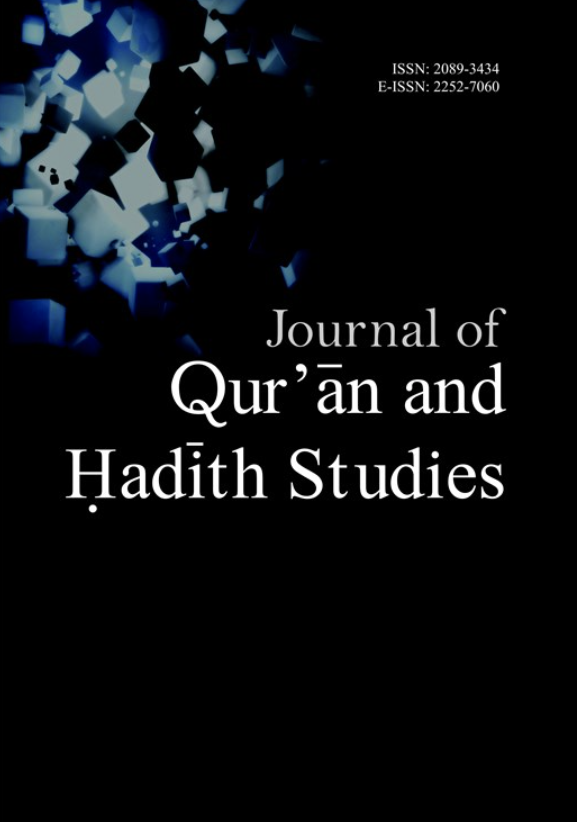When Women Disrupt Prayer? Rethinking a Controversial Hadith through Al-Adlabi’s Matan Criticism
DOI:
https://doi.org/10.15408/quhas.v14i2.46533Keywords:
Criticism of Matan, Hadith, Women, Prayer, al-AdlabiAbstract
The hadith that mentions women, donkeys, and dogs can cancel prayers when passing in front of people who pray has caused controversy, mainly because it is considered to contain gender bias. This study aims to examine the validity of the matan hadith through the approach of matan criticism according to al-Adlabi in Manhaj Naqd al-Matn 'Inda 'Ulamā' al-Ḥadīth al-Nabawī. The method employed is a literature study that involves tracing the hadith in al-Kutub al-Tis'ah and analyzing it based on four criteria: conformity with the Qur'an, sahih hadith, the Prophet's sirah, rationality, and historical context, as well as editorial feasibility. The results of the analysis show that, although the sanad of the hadith is considered authentic, it contains problems: it is not in line with the Qur'an, it contradicts Aisha's history and the Prophet's practice, and it juxtaposes women with animals in the context of worship. This study emphasizes the importance of critically analyzing the hadith so that our understanding of it remains in harmony with the values of justice, common sense, and humanity in Islam.
References
Al-Adlabi, S. I. A. (1983). Manhaj Naqd al-Matn ‘inda ‘Ulamâ al-Hadîts al-Nabawî. Dâr al-Ifaq al Jadîdah.
Al-Bukhārī, M. ibn I. (2000). Ṣaḥīḥ al-Bukhārī. Dār Ibn Kathīr.
Al-Ḥajjāj, M. ibn. (1991). Ṣaḥīḥ Muslim. Tahqīq Muḥammad Fu’ād ‘Abd al-Bāqī. Dār Iḥyā’ al-Turāth al-‘Arabī.
Al-Jawziyyah, I. Q. (1970). al-Manār al-Munīf fī al-Ṣaḥīḥ wa al-Ḍa‘īf. Maktabah al-Qāhirah.
Al-Sijistānī, A. D. (2009). Sunan Abī Dāwūd. Dār al-Fikr.
Anggraeni, L. (2024). Misogynistic hadith : Critical analysis of fatima mernissi ’ s hermeneutical method. Humanistika: Jurnal Keislaman, 10(2), 267–282. https://doi.org/https://doi.org/10.55210/humanistika.v10i2.1778
Anshori, M. (2016). Kajian Ketersambungan Sanad (Ittişāl Al-Sanad). Jurnal Living Hadis, 1(2), 294. https://doi.org/10.14421/livinghadis.2016.1123
Baharuddin, M. A. (2014). Visi-Misi Ma’ânî al-H?adîth dalam Wacana Studi H?adîth. Tafáqquh: Jurnal Penelitian Dan Kajian Keislaman, 2(2), 36–55. https://doi.org/10.52431/tafaqquh.v2i2.29
Fata, Z., Hidayat, M. S., & Sahidin, A. (2023). Dialektika Teks dan Konteks dalam Framework Pemahaman Hadis. AL QUDS : Jurnal Studi Alquran Dan Hadis, 7(2), 271. https://doi.org/10.29240/alquds.v7i1.5002
Hamisan@khair, N. S. (2022). Contextualising Arguments on Deficiency of Women’s Intelligence and Religion: Analytical Study on the Prophetic Traditions. Akademika, 92(2), 47–56. https://doi.org/10.17576/akad-2022-9202-04
Ḥanbal, A. ibn. (2001). Musnad Aḥmad, Mu’assasat al-Risālah, tahqīq: Shu‘ayb al-Arna’ūṭ.
Hikmah, N., Pangestu, S. A., & Luthfia, N. (2023). Analisis Kriteria Kesahihan Matan dalam Hadis : Kajian Teori dan Metodologi. Journal of Hadith Studies, 6, 99–113. https://doi.org/10.32506/johs.v6i2-02
Irfan, M. M. (2020). Perempuan Sebagai Pembatal Salat: Studi Atas Pandangan Nasr Ad-Din a-Albani Dan Fatima Mernissi. Al-Mazaahib: Jurnal Perbandingan Hukum, 8(1), 1. https://doi.org/10.14421/al-mazaahib.v8i1.2211
Kholishuddin, K. (2020). Penggunaan Pendekatan Maqasid Shari’ah Sebagai Instrumen Kontekstualisasi Makna Hadis. Nabawi: Journal of Hadith Studies, 1(1), 74–95. https://doi.org/10.55987/njhs.v1i1.4
Maihula, J. S., & Abdulkadir, M. M. (2022). In-depth Analysis on the Methodology of Sanad and MatanCriticisms: The Perspective of Hadith Scholars. IAR Journal of Humanities and Social Science, 3(01), 55–60. https://doi.org/10.47310/iarjhss.2022.v03i01.008
Mājah, I. (2004). Sunan Ibn Mājah. Dār Iḥyā’ al-Kutub al-‘Arabiyyah.
Muhammad Habib Zainul Huda. (2022). Intertekstualitas Hadis Perempuan Shalat Berjamaah Di Masjid. Academic Journal of Islamic Principles and Philosophy, 3(1). https://doi.org/10.22515/ajipp.v3i1.5053
Musyafiq, A., & Nur, Q. (2004). Salahudin ibn Ahmad al Adlabi, Metodologi Kritik Matan Hadis. Gaya Media Pratama.
Mutammimah, B., Husni, M., & Sumbulah, U. (2023). Hadith Authentication Method: Concept, Application and Critique of Orientalist Skepticism. Religia, 26(1), 58–75. https://doi.org/10.28918/religia.v26i1.863
RI, K. A. (2019). Al-Qur’an dan terjemahannya.
Ridwan, M. (2023). Pemahaman Hadis Sutrah dalam Shalat: Tanggapan terhadap Kaum Feminis yang Keberatan dengan “Binatang dan Wanita itu Sederajat.” Jurnal Riset Agama, 3(1), 266–284. https://doi.org/10.15575/jra.v3i1.20544
Rofiq, M. (2015). Memahami Hadis Misoginis Perspektif Maqasid Syari‘AH: Studi Hadis yang Menyamakan antara Keledai, Anjing dan Perempuan. ESENSIA: Jurnal Ilmu-Ilmu Ushuluddin, 16(1), 43–56. https://doi.org/10.14421/esensia.v16i1.986
Siregar, I. (2018). Kritik Kontekstualisasi Pemahaman Hadis M. Syuhudi Ismail. TAFSE: Journal of Qur’anic Studies, 2(1), 61. https://doi.org/10.22373/tafse.v2i1.8075
Suparman, T. N. A., & Kosasih, E. (2025). Analisis Kaidah-Kaidah Sanad Hadits Dari Aspek Rawi: Identitas Rawi. Tashdiq: Jurnal Kajian Agama Islam, 10(2), 1–2. https://doi.org/doi.org/10.3783/tashdiqv2i9.2461
Syafi, M. (2011). Bangunan Masjid Pada Masa Nabi Dan Implikasinya Terhadap Jamaah Masjid Perempuan. Musãwa Jurnal Studi Gender Dan Islam, 10(1), 89. https://doi.org/10.14421/musawa.2011.101.89-106
Syaikhudin, S. (2011). Perempuan Yang Membatalkan Shalat. Musãwa Jurnal Studi Gender Dan Islam, 10(1), 107. https://doi.org/10.14421/musawa.2011.101.107-121
Tangngareng, T. (2016). METHODOLOGY OF HADITH CONTENT CRITICISM: A Study on the Thought of Salah al-Din bin Ahmad al-Adlabi. ESENSIA: Jurnal Ilmu-Ilmu Ushuluddin, 17(1), 97. https://doi.org/10.14421/esensia.v17i1.1281
Umam, K., Bustomi, M. Y., & Maulana, A. (2024). Kesetaraan Gender dalam Al-Qur’an dan Hadis: Meluruskan Pemahaman Nash Misoginis. Tadabbur: Jurnal Integrasi Keilmuan, 3(01), 1–15. https://doi.org/10.15408/tadabbur.v3i01.41458
Yunita, Y. (2016). Fatima Mernissi Dan Simbol Perlawanan Terhapad Hadith- Hadith Misoginis (Kajian Terhadap Pandangan Fatima Mernissi mengenai Hadith “Wanita, Anjing dan Keledai Membatalkan Shalat ” riwayat AbÅ« Hurairah). Dialogia, 13(1), 19–30. https://doi.org/10.21154/dialogia.v13i1.276
Downloads
Published
Issue
Section
License
Copyright (c) 2025 Muhammad Fadhil Wathani, Ahmad Musyafiq, Nikmah Rochmawati, Mahadi Rahman, Zufriyatun

This work is licensed under a Creative Commons Attribution-ShareAlike 4.0 International License.






